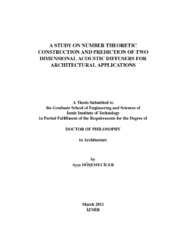Please use this identifier to cite or link to this item:
https://hdl.handle.net/11147/2886Full metadata record
| DC Field | Value | Language |
|---|---|---|
| dc.contributor.advisor | Doğan, Fehmi | - |
| dc.contributor.author | Döşemeciler, Ayşe | - |
| dc.date.accessioned | 2014-07-22T13:48:33Z | - |
| dc.date.available | 2014-07-22T13:48:33Z | - |
| dc.date.issued | 2011 | - |
| dc.identifier.uri | http://hdl.handle.net/11147/2886 | - |
| dc.description | Thesis (Doctoral)--İzmir Institute of Technology, Architecture, İzmir, 2011 | en_US |
| dc.description | Includes bibliographical references (leaves: 72-77) | en_US |
| dc.description | Text in English; Abstract: Turkish and English | en_US |
| dc.description | xiv, 172 leaves | en_US |
| dc.description.abstract | Defined as the scattering of sound independent from angle, optimum diffusion is very important for the perception of musical sound. For this purpose, Schroeder used mathematical number sequences to propose ʼreflection phase grating diffusersʼ, of two main types: Single plane or one-dimensional (1D) diffusers that scatter sound into a hemi-disc, and two dimensional (2D) diffusers that scatter into a hemisphere to disperse strong specular reflections without removing sound energy from the space, which is the main advantage of these devices. Currently, two methods are used to design 2D diffusers:Product Array and Folding Array Methods. Both are based on number theory and used methodologically in the field of acoustics, producing results that offer limited diffusion characteristics and design solutions for a variety of architectural spaces ranging from concert halls to recording studios where Schroeder diffusers are widely used. This dissertation proposes Distinct Sums Property Method originally devised for watermarking digital images, to construct adoptable 2D diffusers through number theoretical construction and prediction. At first, quadratic residue sequence based on prime number 7 is selected according to its autocorrelation properties as the Fourier transform of good autocorrelation properties gives an even scattered energy distribution. Then Distinct Sums Property Method is applied to construct 2D arrays from this sequence from which well depths and widths are calculated. Third, the aimed scattering and diffusion properties of the modeled 2D diffuser are predicted by Boundary Element Method which gives approximate results in accordance with the measurements based on Audio Engineering Society Standards. Fourth, polar responses (i.e. the scattering diagrams for specific angles) in each octave band frequency are obtained. Finally, predicted diffusion coefficients for uniform scattering are calculated and compared to the reference flat surfaceʼs coefficients and previous studieʼs results. | en_US |
| dc.language.iso | en | en_US |
| dc.publisher | Izmir Institute of Technology | en_US |
| dc.rights | info:eu-repo/semantics/openAccess | en_US |
| dc.subject.lcsh | Architectural acoustics | en |
| dc.subject.lcsh | Acoustical engineering | en |
| dc.title | A Study on Number Theoretic Construction and Prediction of Two Dimensional Acoustic Diffusers for Architectural Applications | en_US |
| dc.type | Doctoral Thesis | en_US |
| dc.department | Thesis (Doctoral)--İzmir Institute of Technology, Architecture | en_US |
| dc.relation.publicationcategory | Tez | en_US |
| dc.identifier.wosquality | N/A | - |
| dc.identifier.scopusquality | N/A | - |
| item.languageiso639-1 | en | - |
| item.grantfulltext | open | - |
| item.fulltext | With Fulltext | - |
| item.openairecristype | http://purl.org/coar/resource_type/c_18cf | - |
| item.openairetype | Doctoral Thesis | - |
| item.cerifentitytype | Publications | - |
| Appears in Collections: | Phd Degree / Doktora | |
Files in This Item:
| File | Description | Size | Format | |
|---|---|---|---|---|
| T000895.pdf | DoctoralThesis | 4.18 MB | Adobe PDF |  View/Open |
CORE Recommender
Page view(s)
246
checked on Jun 10, 2025
Download(s)
308
checked on Jun 10, 2025
Google ScholarTM
Check
Items in GCRIS Repository are protected by copyright, with all rights reserved, unless otherwise indicated.